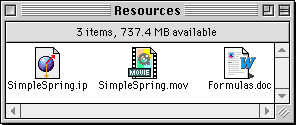| Problem: |
| This is the standard example for simple harmonic motion. A box of mass 10kg is attached to a wall by a spring with a spring constant of 50. If the box is displaced -1.00m then allowed to oscillate horizontally on a frictionless surface, find the velocity when the acceleration is zero, the acceleration when the velocity is zero, and the period of the oscillator. |
|
Solution:
|
|
Note that the EPE and the translational KE bar graphs both approach the same maximum value. Look at the acceleration, velocity, and force vectors and note when they are increasing, decreasing, and changing direction. |

| The equation above is used to find the period of an SHM spring oscillator. For a simple pendulum, substitute 'L' for 'm' and 'g' for 'k'. For a physical pendulum, the numerator becomes 'mgd' and the denominator is the moment of inertia. |

| The force on the box provided by the spring can be found by multiplying the spring constant by the displacement of the box from equilibruim position. |

| Because the force equals mass times acceleration as well as the force found by the spring (F=ks), ma equals ks. Dividing by m gives the acceleration. Since 'k' and 'm' are given, only the displacement 's' needs to be found to find the acceleration. |

| Energy is conserved in this example. Therefore the total energy at any point in time equals the total energy at any other time. Total energy equals kinetic energy plus potential energy, or, in this example, KE+EPE. |

| Because energy is conserved, substituting equations for KE and EPE implies the above equation. . |

| Assume that one of the points in time is the time when the box is at its maximum displacement so that the box has no velocity. The KE at that point equals zero and s is a maximum, thus equaling the amplitude 'A'. Using the conservation of energy equation, solve for v at any point in time to get the equation above. The velocity at any given point in time equals the square root of the spring constant multiplied by the amplitude squared minus the square of the displacement of the box divided by the mass of the box. |
|
Velocity @ a=0
|
| To find the velocity when acceleration equals zero, set a=0 and find the displacement 's' using the a=ks/m equation. Use this value as the 's' value in the equation used to find velocity when acceleration equals zero. Substituting 50 for 'k', 10 for 'm', and 0 for 'a', 's' becomes zero, implying that when the acceleration is zero, the box must be at the equilibrium point. Velocity thus equals the square root of kA^2/m. The amplitude is 1.00m so veolcity equals 5m/s. Note that this is the maximum velocity achieved by the block. The maximum velocity of a block attached to a simple spring always occurs when the acceleration equals zero, making KE a maximum and EPE zerom and the block is at the equilibruim point. |
|
Acceleration @ v=0
|
| Find the position of the spring when the velocity equals zero by setting the equation giving velocity equal to zero. Use the value of the resulting position as the value of 's' in the equation giving acceleration to find the acceleration when velocity equals zero. 's' equals the maximum displacement, or 'A', when velocity equals zero. The value of 's' is therefore 1.00m. Acceleration is the spring constant times the displacement divided by the mass, and equals 5m/s^2 when velocity equals zero. Note that this is the maximum acceleration possible for the box. The maximum acceleration of a block attached to a simple spring occurs when the velocity equals zero, making KE zero and EPE a maximum, and the block is at its maximum displacement. |
|
Period
|
| To find the period of the oscillating box, use the appropriate equation above. Substituting values for 'm' and 'k', the period equals pi multiplied by 2 divided by the square root of five. |

|
|
Interactive Physics is a powerful simulation program that is available from MSC Working Knowledge. IP documents are playable with Interactive Physics v1.2 or later. Earlier versions may be compatable.
|
|
Text versions of the equation work are made with Microsoft Equation Editor and are embedded in Microsoft Word documents.
|
|
Movies are saved in QuickTime format available at Apple's site. Get Quicktime 4 today!
|
 |
|
|
|

